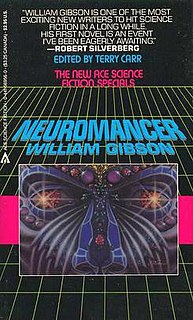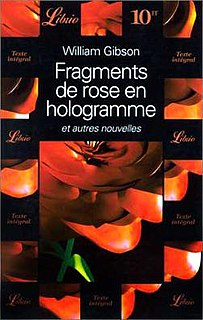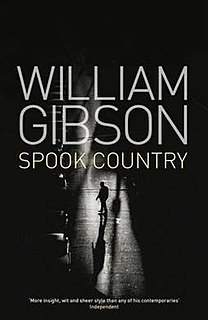Related Research Articles

Cyberpunk is a subgenre of science fiction in a dystopian futuristic setting that tends to focus on a "combination of lowlife and high tech", featuring futuristic technological and scientific achievements, such as artificial intelligence and cybernetics, juxtaposed with societal collapse, dystopia or decay. Much of cyberpunk is rooted in the New Wave science fiction movement of the 1960s and 1970s, when writers like Philip K. Dick, Michael Moorcock, Roger Zelazny, John Brunner, J. G. Ballard, Philip José Farmer and Harlan Ellison examined the impact of drug culture, technology, and the sexual revolution while avoiding the utopian tendencies of earlier science fiction.

Neuromancer is a 1984 science fiction novel by American-Canadian writer William Gibson. Considered one of the earliest and best-known works in the cyberpunk genre, it is the only novel to win the Nebula Award, the Philip K. Dick Award, and the Hugo Award. It was Gibson's debut novel and the beginning of the Sprawl trilogy. Set in the future, the novel follows Henry Case, a washed-up hacker hired for one last job, which brings him in contact with a powerful artificial intelligence.

William Ford Gibson is an American-Canadian speculative fiction writer and essayist widely credited with pioneering the science fiction subgenre known as cyberpunk. Beginning his writing career in the late 1970s, his early works were noir, near-future stories that explored the effects of technology, cybernetics, and computer networks on humans—a "combination of lowlife and high tech"—and helped to create an iconography for the information age before the ubiquity of the Internet in the 1990s. Gibson coined the term "cyberspace" for "widespread, interconnected digital technology" in his short story "Burning Chrome" (1982), and later popularized the concept in his acclaimed debut novel Neuromancer (1984). These early works of Gibson's have been credited with "renovating" science fiction literature in the 1980s.

Count Zero is a science fiction novel by American-Canadian writer William Gibson, originally published in 1986. It is the second volume of the Sprawl trilogy, which begins with Neuromancer and concludes with Mona Lisa Overdrive, and is an example of the cyberpunk subgenre.

Mona Lisa Overdrive is a science fiction novel by American-Canadian writer William Gibson, published in 1988. It is the final novel of the cyberpunk Sprawl trilogy, following Neuromancer and Count Zero, taking place eight years after the events of the latter. The novel was nominated for the Nebula Award for Best Novel, the Hugo Award for Best Novel, and the Locus Award for Best Science Fiction Novel in 1989.
The Sprawl trilogy is William Gibson's first set of novels, composed of Neuromancer (1984), Count Zero (1986), and Mona Lisa Overdrive (1988).
"New Rose Hotel" is a short story by William Gibson, first published in Omni in July 1984 and later included in his 1986 collection Burning Chrome.

Burning Chrome (1986) is a collection of short stories written by William Gibson. Most of the stories take place in Gibson's Sprawl, a shared setting for most of his early cyberpunk work. Many of the ideas and themes explored in the short stories were later revisited in Gibson's popular Sprawl trilogy.
Intrusion Countermeasures Electronics (ICE) is a term used in cyberpunk literature to refer to security programs which protect computerized data from being accessed by hackers.
Bobby Newmark is one of the main characters in the William Gibson novel Count Zero. His handle in the Matrix is "Count Zero", from which the novel derives its name. Newmark is one of several Gibson characters who live through information.

"Johnny Mnemonic" is a science fiction short story by American-Canadian writer William Gibson. It first appeared in Omni magazine in May 1981, and was subsequently included in Burning Chrome, a 1986 collection of Gibson's short fiction. It takes place in the world of Gibson's cyberpunk novels, predating them by some years, and introduces the character Molly Millions, who plays a prominent role in the Sprawl trilogy of novels.

Molly Millions is a recurring character in stories and novels written by William Gibson, particularly his Sprawl trilogy. She first appeared in "Johnny Mnemonic", to which she makes an oblique reference in Neuromancer. She later appeared in Mona Lisa Overdrive under the name "Sally Shears".
The Bridge trilogy is a series of novels by William Gibson, his second after the successful Sprawl trilogy. The trilogy comprises the novels Virtual Light (1993), Idoru, (1996) and All Tomorrow's Parties (1999). A short story, "Skinner's Room", was originally composed for Visionary San Francisco, a 1990 museum exhibition exploring the future of San Francisco.
"The Belonging Kind" is a science fiction short story by cyberpunk authors William Gibson and John Shirley. It was first published in the horror anthology Shadows 4 edited by Charles L. Grant in 1981, later to be included along with several other stories in Gibson's collection Burning Chrome.

"Fragments of a Hologram Rose" is a science fiction short story by William Gibson. It was Gibson's first published work, originally appearing in 1977 in Unearth 3, a short-lived science fiction collection magazine which retailed for $1.00; Gibson was paid $27 for the story. It tells the story of a jilted ex-lover who relies on artificial sense-recordings to sleep, in a dark, polluted city. It was subsequently published in Burning Chrome, a collection of Gibson's early short fiction.
"The Gernsback Continuum" is a 1981 science fiction short story by American-Canadian author William Gibson, originally published in the anthology Universe 11 edited by Terry Carr. It was later reprinted in Gibson's collection Burning Chrome, and in Mirrorshades, edited by Bruce Sterling. With some similarity to Gibson's later appraisal of Singapore for Wired magazine in Disneyland with the Death Penalty, as much essay as fiction, it depicts the encounters of an American photographer with the period futuristic architecture of the American 1930s when he is assigned to document it for fictional London publishers Barris-Watford, and the gradual incursion of its cinematic future visions into his world. The "Gernsback" of the title alludes to Hugo Gernsback, the pioneer of early 20th century American pulp magazine science fiction.

The works of William Gibson encompass literature, journalism, acting, recitation, and performance art. Primarily renowned as a novelist and short fiction writer in the cyberpunk milieu, Gibson invented the metaphor of cyberspace in "Burning Chrome" (1982) and emerged from obscurity in 1984 with the publication of his debut novel Neuromancer. Gibson's early short fiction is recognized as cyberpunk's finest work, effectively renovating the science fiction genre which had been hitherto considered widely insignificant.
"Dogfight" is a science fiction short story by American writers Michael Swanwick and William Gibson, first published in Omni in July 1985. The story was also included in Gibson's 1986 short story collection Burning Chrome.

Spook Country is a 2007 novel by speculative fiction author William Gibson. A political thriller set in contemporary North America, it followed on from the author's previous novel, Pattern Recognition (2003), and was succeeded in 2010 by Zero History, which featured much of the same core cast of characters. The plot comprises the intersecting tales of three protagonists: Hollis Henry, a musician-turned-journalist researching a story on locative art; Tito, a young Cuban-Chinese operative whose family is on occasion in the employ of a renegade ex-CIA agent; and Milgrim, a drug-addled translator held captive by Brown, a strangely authoritarian and secretive man. Themes explored include the ubiquity of locative technology, the eversion of cyberspace and the political climate of the United States in the aftermath of the September 11, 2001 attacks.
References
- ↑ Mark Neale (director), William Gibson (subject) (2000). No Maps for These Territories (Documentary). Docurama.
- ↑ The Locus Index to SF Awards. Archived February 7, 2011, at the Wayback Machine
- ↑ Wills, David (1995). Prosthesis. Stanford: Stanford University Press. p. 83. ISBN 978-0-8047-2459-3.
- ↑ Prucher, Jeff (2007). "cyberspace". Brave New Words: The Oxford Dictionary of Science Fiction . Oxford University Press. p. 31. ISBN 978-0-19-530567-8. OCLC 76074298.
- ↑ Gibson, William (May 1994). "William Gibson Interviewed by Giuseppe Salza" (Interview). Interviewed by Giuseppe Salza. Cannes. Archived from the original on 2011-10-11. Retrieved 2007-10-28.